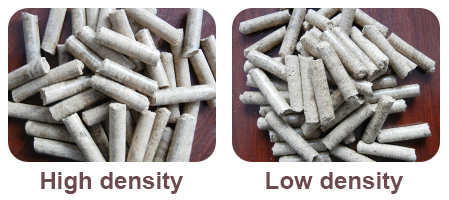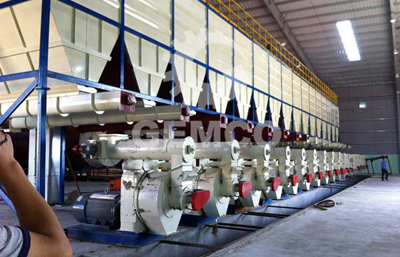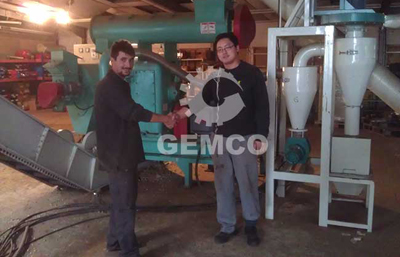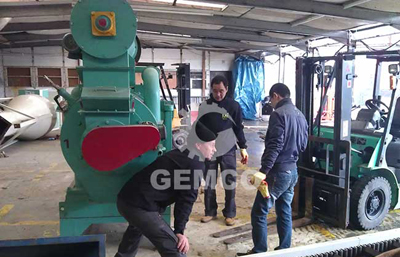What's the best wood pellet fuel for pellet stove?
Wood pellets are extruded and molded by pellet mills from agriculture and forestry wastes. The diameter is 6-10mm, the length is 20-40mm, the density is 0.8-1.4t/m3, and the moisture content is 14-20%. They are easy to transport and store. The calorific value is equal to that of medium coal. The burning time is long, and the burning temperature is high.
Nowadays, wood pellet fuel is widely applied in pellet stoves and industrial boilers to replace coal, fuel oil. It can save energy resources and relieve air pollution. Low cost and easy application make it popular in developed countries, and more people in developing countries choose to use wood pellets.

How to identify the wood pellet quality?
- Observe the appearance of wood pellets. High quality wood pellets have bright color and gloss.
- Smell the wood pellets. High quality wood pellets don’t need additives in molding, so they smells like sawdust or straws, with no unusual smells.
- Touch the wood pellets with your hands. If the pellets are hard, the surface is smooth, with no cracks, they are likely to be high quality. If the surface is rough, and break easily when you pinch it, it is low-quality pellets.
- Observe the ash residues after burning. The less the ash residues, the purer the raw materials. If the ash residues are much, the raw materials are likely to contains much impurities.
- Observe the burnt wood pellets. High quality wood pellets looks light yellow or brown after burning, while inferior wood pellets looks black after burning.
- Make certain what raw materials the wood pellets are made. The best wood pellets are made of hardwood or softwood sawdust, like pine, fir, poplar, birch, etc. The secondary wood pellets are made of crop wastes, like straw, stalks, shells, etc. The inferior wood pellets are made of household garbage.

Calorific value of different biomass materials
| Types | raw material source | lower calorific value kcal/kg | Density t/m3 | Ash content % |
|---|---|---|---|---|
| Pine | cedar, spurce, fir | 4300-4500 | >=1.20 | <=0.9 |
| Hardwood | Xylosma, Catalpa, elm | 4500 | >=1.2 | <=0.9 |
| Softwood | poplar, birch | 4300 | >=1.20 | <=1.1% |
| Crop waste | Bean stalk, cotton stalk, peanut shell | 3800 | >=1.15 | <=6.0% |
| corn stalk, rape shoot | 3700 | >=1.15 | <=6.0 | |
| wheat straw | 3500 | >=1.10 | <=7.0 | |
| potato straw | 3400 | >=1.10 | <=7.0 | |
| rice straw | 3200 | >=1.10 | <=8.0 |
What the best density of wood pellet fuel?
Density is an important indicator of wood pellet quality. It also determines the stacking density. Generally, the density of wood pellet fuels are usually between 1.1-1.3t/m3.
High density wood pellets are hard and smooth, but it will increase the production cost. To achieve high density, we should increase the compression ratio of pellet mill die, and the clearance between roller and die. These will aggravate the abrasion of dies, and increase the possibility of pellet mill blockage.
On the contrary, if the compression ratio is low, and the clearance between roller and die is short, the wood pellet density will be low. The extrusion strength is low, the production is high, but the molding rate is low. The wood pellets will be easy to crack.
Therefore, it’s not recommend to pursue over-high or over-low wood pellet density. For home use, the density should be 1.1-1.3t/m3. High density can save stacking room, reduce cracks or broken materials in use. In industrial boilers, the best density should be 0.8-1.1t/m3. Low density wood pellets burn more sufficiently and less likely to coke in boilers.

What affects the wood pellet quality?
Moisture content
In the molding of wood pellets, some water can increase the adhesive force in materials, so as to improve the molding effects.
Over-high moisture content will affect the wood pellet quality. The extra water attaches to the surface of raw materials and hinder the them from boning tightly, so that the density and durability is low.
Generally, the best moisture content of raw materials should be between 10% and 16%. Both higher or lower moisture content are bad for the wood pellet quality.
Fineness of raw materials
The granularity of raw materials has great impact on the wood pellet quality and production efficiency. The finer the raw materials, the higher the wood pellet quality, the less the abrasion of roller and die. If the raw materials contain large particles, it will cause the wood pellet crack, and generate broken materials.

Performance and parameters of the equipment
The wood pellet quality is affected by the compression ratio of pellet mill die, the die hole size, the roughness of the wall, the diameter and length of pressure-relief holes.
To achieve the best molding effects, different materials requires different compression ratios and hole sizes.
If the wall of the dies have many abrasions, nicks, and the effective thickness decrease, the wood pellet quality would be affected.
The cooling effect
The wood pellet temperature is as high as 70℃~100℃ when it is just produced by the pellet machine. Hot pellets are soft and easy to crack. They need to be cooled down before packed into bags.
Usually we use a counterflow pellet cooler. It can not only cool down the wood pellets, but also improve the hardness. The cooled pellets looks smooth with no cracks.
We receive enquiries in English, Español (Spanish), Русский язык (Russian), Français (French) and العربية (Arabic). Our professional team will reply to you within one business day. Please feel free to contact us!




